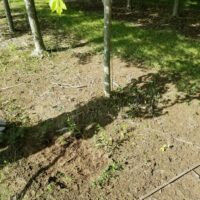 Purdue University - Extension - Forestry and Natural Resources
Purdue University - Extension - Forestry and Natural Resources
Got Nature? Blog
Purdue Landscape Report, Using Pneumatic Digging Equipment to Correct Root Deformations, Deep Planting, and Compaction on Established Trees: When transplanting trees, it is important to consider the long-term viability. Since the typical life span of an urban tree is 7-20 years (USDA), proper establishment techniques are very important to decrease this mortality rate. When a tree becomes established, it is much more difficult to correct below ground problems.
Root deformations can occur for many reasons in established trees, but the most common are due to not making corrections prior to transplanting. Plants that have girdling and circling roots must  be addressed at the time of planting. If this issue is not addressed many problems may ensue when the tree is established, which includes decline, tree failure, blow-overs, and more.
be addressed at the time of planting. If this issue is not addressed many problems may ensue when the tree is established, which includes decline, tree failure, blow-overs, and more.
Another common problem that occurs at transplanting is deep planting. In the past, plants were often planted deep in the nursery for two main reasons: 1) cold protection of the roots and root flare and 2) prevent the use of staking. In fields that are cultivated, the soil often mounds around the trees which can increase the depth of the root flare. Additionally, when planting into the landscape, trees can be planted too deep, exacerbating the problems associated with planting too deep.
Deep planting can cause an increase in disease, insects, decreased tolerance to flooded soils, adventitious roots, and root circling/girdling. Day and Harris (2008) found that there is significantly more girdled root at 30 cm below grade than at grade or 15 cm below grade. They also found that excavated trees at 30 cm had more girdling roots than non-excavated roots at 30 cm.
Compaction can become an issue when trees are located in high traffic areas. Compaction will cause a decline in trees over time and become more susceptible to increased insect and disease pressure.
Excavating the root system with a pneumatic digger is a method that can be used to correct all of these problems. Removing soil around the tree will allow root deformations to be located and corrected. Removing the soil around the collar to correct planting depth and girdling roots will increase the longevity of the tree. Compaction can be reduced by using a pneumatic digger to remove the soil from the root hairs that are typically located in the top 6 inches of soil for most trees (Morris, et.al., 2009).
To read the full article with additional images and video please visit: Using Pneumatic Digging Equipment to Correct Root Deformations, Deep Planting, and Compaction on Established Trees
For more information on correcting root problems after a tree becomes established:
Stem Girdling Roots
Root Growth on Urban Trees
Tree Root Problems
Air Digging Trench or Loosening Soil
Tree Planted Too Deeply
Roots and the Pneumatic Soil Excavation Tool
Tree Preservation Efforts
Getting Roots Right
Supersonic Air Jets Preserve Tree Roots in Underground Pipeline Installation
More resources:
Root Rot in Landscape Plants, The Education Store
Ask The Expert: Tree Inspection, Purdue Extension- FNR YouTube Channel
Ask The Expert: Tree Selection and Planting, Purdue Extension- FNR YouTube Channel
Surface Root Syndrome, The Education Store, Purdue Extension resource center
The Nature of Teaching: Trees of the Midwest, The Education Store
Tree Appraisal and the Value of Trees, The Education Store
Construction and Trees: Guidelines for Protection, The Education Store
Kyle Daniel, Extension Specialists
Purdue University Department of Forestry and Natural Resources

Recent Posts
- Rebuilding Indiana’s Hellbender Habitat – Morning AgClips
Posted: September 17, 2024 in Forests and Street Trees, Urban Forestry, Wildlife - Purdue Alumnus Magazine Highlights FNR Graduate and Nature of Teaching Program
Posted: September 13, 2024 in Got Nature for Kids, Nature of Teaching, Wildlife - Enjoy Your Trees While Checking Them – Purdue Landscape Report
Posted: September 12, 2024 in Forestry, Forests and Street Trees, Urban Forestry, Wildlife, Woodlands - IN DNR Division of Entomology & Plant Pathology Shares Kudzu Program
Posted: September 9, 2024 in Forestry, How To, Invasive Plant Species, Plants, Uncategorized, Wildlife - Reserved Hunt Applications Now Open – MyDNR
Posted: September 4, 2024 in Forestry, Wildlife, Woodlands - What the Fluff?! – Purdue Landscape Report
Posted: September 3, 2024 in Forestry, Invasive Plant Species, Plants, Urban Forestry, Wildlife, Woodlands - Announcing-New Indiana Woodland Steward Newsletter
Posted: September 2, 2024 in Forestry, Timber Marketing, Wildlife, Woodlands - The Summer of Triclopyr – Purdue Landscape Report
Posted: August 21, 2024 in Disease, Forestry, Forests and Street Trees, Invasive Plant Species, Urban Forestry, Wildlife - Flying Into July: Bird Banding Season Begins – MyDNR
Posted: August 6, 2024 in Alert, Forestry, Wildlife - Researchers Study Deer-Vehicle Collision Reduction Method
Posted: July 31, 2024 in Safety, Wildlife
Archives
Categories
- Alert
- Aquaculture/Fish
- Aquatic/Aquaculture Resources
- Ask the Expert
- Christmas Trees
- Community Development
- Disease
- Drought
- Forestry
- Forests and Street Trees
- Gardening
- Got Nature for Kids
- Great Lakes
- How To
- Invasive Animal Species
- Invasive Insects
- Invasive Plant Species
- Land Use
- Natural Resource Planning
- Nature of Teaching
- Plants
- Podcasts
- Ponds
- Publication
- Safety
- Spiders
- Timber Marketing
- Uncategorized
- Urban Forestry
- Webinar
- Wildlife
- Wood Products/Manufacturing
- Woodland Management Moment
- Woodlands